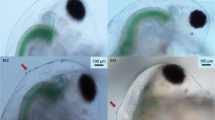Abstract
Larval Tisbe holothuriae Humes exposed to anionic detergent (0.5 mg l-1 sodium dodecyl benzene sulphonate) were found to survive better than control larvae. The detergent appears to enhance viability by relaxing inhibitory interactions between nauplii. This conclusion is inferred from the following experimental observations: (1) crowding depresses larval viability; (2) the effect of crowding on viability is indirect, and results from behavioural changes which reduce contact with food; (3) detergent exposure delays or suppresses the behavioural response to crowding. The nature of the interactions which modify behaviour is unknown, but evidence suggests that close encounters between nauplii are important, and that they may lead to the impairment of distance-chemoreception. Naupliar antagonism could have evolved as a mechanism for staggering larval development or as a means of reducing the relative fitness of neighbouring individuals.
Similar content being viewed by others
Literature cited
Bardach, J. E., M. Fujiya and A. Hall: Detergents: effects on the chemical senses of the fish Ictalurus natalis (le Sueur). Science, N. Y. 148, 1605–1607 (1965)
Battaglia, B.: Cultivation of marine copepods for genetic and evolutionary research. Helgoländer wiss. Meeresunters. 20, 385–392 (1970)
Bergmans, M.: A demographic study of the life cycle of Tisbe furcata (Baird, 1837) (Copepoda: Harpacticoida)., J. mar. biol. Ass. U.K. 61, 691–705 (1981)
Buskey, E. J.: Swimming pattern as an indicator of the roles of copepod sensory systems in the recognition of food. Mar. Biol. 79, 165–175 (1984)
Caughley, G. and C. J. Krebs: Are big mamals simply little mammals writ large? Oecologia (Berlin) 59, 7–17 (1983)
Chitty, D.: The natural selection of self regulatory behaviour in animal populations. Proc. ecol. Soc. Aust. 2, 51–78 (1967)
Fava, G.: Osservazioni ecologiche sulle specie di Tisbe (Copepoda, Harpacticoida) della laguna di Marano. Atti Ist. veneto Sci. 138, 39–51 (1980)
Fava, G.: Tisbe (Copepoda: Harpacticoida) species from the Lagoon of Grado. Archo Oceanogr. Limnol. 20, 131–151 (1983)
Fava, G. and E. Crotti: Effect of crowding on nauplii production during mating time in Tisbe clodiensis and T. holothuriae (Copepoda, Harpacticoida). Helgoländer wiss: Meeresunters. 32, 466–475 (1979a)
Fava, G. e E. Crotti: Effetto di un detersivo commerciale e di uno dei suoi componenti, LAS, sulla produzione di nauplii in Tisbe holothuriae (Copepoda, Harpacticoida) in condizioni di alto e basso affollamento. Atti Accad. naz. Lincei Rc. 66, 223–231 (1979b)
Fava, G., I. Lazzaretto-Colombera M. Cervelli: Carico genetico in Tisbe (Copepoda, Harpacticoida). II. T. holothuriae e T. bulbisetosa della laguna di Venezia. Atti Accad. naz. Lincei Rc. 60, 699–709 (1976)
Fava, G. C. Ringoli: Sopravvivenza da nauplio ad adulto, a diversi gradi di affollamento, nella specie polimorfa Tisbe clodiensis (Copepoda, Harpacticoida). Archo Oceanogr. Limnol. 19, 157–167 (1979)
Gaudy, R., et J. P. Guérin: Dynamique des populations de Tisbe holothuriae (Crustacea: Copepoda) en élevage sur trois régimes artificiels différents. Mar. Biol 39, 137–145 (1977)
Hicks, G. R. F. and B. C. Couil. The ecology of marine meiobenthic harpacticoid copepods. Oceanogr. mar. Biol. A. Rev. 21, 67–175 (1983)
Hoppenheit, M.: Zur Dynamik exploitierter Populationen von Tisbe holothuriae (Copepoda, Harpacticoida). I. Methoden, erneuerung. Helgoländer wiss. Meeresunters. 27, 235–253 (1975)
Hoppenheit, M.: Zur Dynamik exploitierter Populationen von Tisbe holothuriae (Copepoda, Harpacticoida). III. Reproduktion, Geschlechtsverhältnis, Entwicklungsdauer und Überlebenszeit. Helgoländer wiss. Meeresunters. 28, 109–137 (1976)
Lopez, G. W.: Short-term population dynamics of Tisbe cucumariae (Copepoda: Harpacticoida). Mar. Biol. 68, 333–341 (1982)
Marcotte, B. M.: Behaviourally defined ecological resources and speciation in Tisbe (Copepoda: Harpacticoida). J. Crustacean Biol. 4, 404–416 (1984)
McCauley, D. E.: Demographic and genetic responses of two strains of Tribolium castaneum to a novel environment. Evolution, Lawrence, Kansas 32, 398–415 (1978)
Poulet, S. A. and G. Ouellet: The role of amino acids in the chemosensory swarming and feeding of marine copepods. J. Plankton Res. 4, 341–361 (1982)
Rieper, M.: Bacteria as food for marine harpacticoid copepods. Mar. Biol. 45, 337–345 (1978)
Rieper, M.: Feeding preferences of marine harpacticoid copepods for various species of bacteria. Mar. Ecol. Prog. Ser. 7, 303–307 (1982)
Rothstein, S. I.: Gene frequencies and selection for inhibitory traits with special emphasis on the adaptiveness of territoriality. Am. Nat. 113, 317–331 (1979)
Sonleitner, F. J.: Factors affecting egg cannibalism and fecundity in populations of adult Tribolium castaneum Herbst. Physiol. Zoöl. 34, 233–255 (1961)
Volkmann-Rocco, B.: Tisbe battagliai n. sp., a sibling species of Tisbe holothuriae Humes (Copepoda, Harpacticoida). Archo Oceanogr. Limnol. 17, 259–273 (1972)
Walker, I.: Mechanisms of density-dependent population regulation in the marine copepod Amphiascoides sp. (Harpacticoida). Mar. Ecol. Prog. Ser. 1, 209–221 (1979)
Author information
Authors and Affiliations
Rights and permissions
About this article
Cite this article
Brand, G.W. Effect of crowding on larval viability in Tisbe holothuriae (Copepoda: Harpacticoida). Mar. Biol. 88, 67–72 (1985). https://doi.org/10.1007/BF00393045
Accepted:
Issue Date:
DOI: https://doi.org/10.1007/BF00393045




